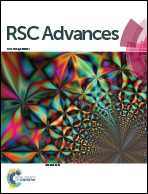Self-assembly Z-scheme heterostructured photocatalyst of Ag2O@Ag-modified bismuth vanadate for efficient photocatalytic degradation of single and dual organic pollutants under visible light irradiation
Abstract
Novel Ag2O@Ag-modified BiVO4 composites with highly efficient visible light photocatalytic activity were synthesized by a facile pH-mediated chemical precipitation method accompanied by a self-built Z-scheme heterojunction under visible light irradiation in this study. X-ray diffraction (XRD), scanning electron microscopy (SEM), transmission electron microscopy (TEM), Fourier transform infrared spectrometry (FTIR), X-ray photoelectron spectroscopy (XPS), UV-vis diffuse reflectance spectroscopy (UV-vis DRS) analysis and electrochemical measurements demonstrated that an acicular sheaf-like heterojunction was formed. Rhodamine B (RhB), methylene blue (MB) and their mixture were selected as the target pollutants to evaluate the enhanced photocatalytic activities of the as-prepared composites. Compared with pure BiVO4 and Ag2O, Ag2O@Ag@BiVO4 had a high photocatalytic activity because of the efficient separation of electron–hole pairs in the heterojunction construction. The composites with an initial Ag2O : BiVO4 mass ratio of 1 : 10 exhibited the highest degradation efficiency for dye. Experimental results indicated that single RhB or MB could be degraded completely within a short irradiation time (15 min for 10 mg L−1 RhB, 48 min for 20 mg L−1 MB), but there was obviously competition with the active species, resulting in a decrease of the degradation rate for both dyes. Regardless of the suppression effect, a relatively higher photocatalytic performance was also achieved for the dye mixture. Several parameters, including initial dye concentration, calcination temperature, initial pH and mineralization ability are discussed in detail. The kinetics study suggested that photocatalytic degradation processes for single or complex dye were well described by first-order kinetics. Due to the generated Ag–Ag2O self-stability structure, these acicular sheaf-like three-dimensional heterojunction photocatalysts were fairly stable and there was no obvious loss of photocatalytic activity after four consecutive cycles.


 Please wait while we load your content...
Please wait while we load your content...